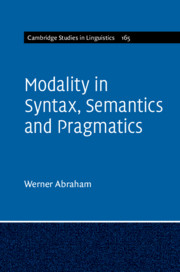Refine search
Actions for selected content:
6584 results in Grammar and Syntax
Appendices
-
- Book:
- Doing English Grammar
- Published online:
- 02 March 2021
- Print publication:
- 11 March 2021, pp 230-233
-
- Chapter
- Export citation
1 - The Place of Grammar
-
- Book:
- Doing English Grammar
- Published online:
- 02 March 2021
- Print publication:
- 11 March 2021, pp 3-16
-
- Chapter
- Export citation
9 - Case Study 3
-
- Book:
- Doing English Grammar
- Published online:
- 02 March 2021
- Print publication:
- 11 March 2021, pp 184-208
-
- Chapter
- Export citation
Appendix 3 (from Chapter 5): Results from Berry (2009a)
- from Appendices
-
- Book:
- Doing English Grammar
- Published online:
- 02 March 2021
- Print publication:
- 11 March 2021, pp 233-233
-
- Chapter
- Export citation
Figure
-
- Book:
- Doing English Grammar
- Published online:
- 02 March 2021
- Print publication:
- 11 March 2021, pp xi-xi
-
- Chapter
- Export citation
Contents
-
- Book:
- Doing English Grammar
- Published online:
- 02 March 2021
- Print publication:
- 11 March 2021, pp v-x
-
- Chapter
- Export citation
Conclusion
-
- Book:
- Doing English Grammar
- Published online:
- 02 March 2021
- Print publication:
- 11 March 2021, pp 226-229
-
- Chapter
- Export citation
10 - Case Study 4
-
- Book:
- Doing English Grammar
- Published online:
- 02 March 2021
- Print publication:
- 11 March 2021, pp 209-225
-
- Chapter
- Export citation
Introduction
-
- Book:
- Doing English Grammar
- Published online:
- 02 March 2021
- Print publication:
- 11 March 2021, pp 1-2
-
- Chapter
- Export citation
Appendix 1 (from Chapter 3): Results from Berry (2014)
- from Appendices
-
- Book:
- Doing English Grammar
- Published online:
- 02 March 2021
- Print publication:
- 11 March 2021, pp 230-231
-
- Chapter
- Export citation
2 - What Is Grammar?
-
- Book:
- Doing English Grammar
- Published online:
- 02 March 2021
- Print publication:
- 11 March 2021, pp 17-42
-
- Chapter
- Export citation
4 - Working with Terminology
-
- Book:
- Doing English Grammar
- Published online:
- 02 March 2021
- Print publication:
- 11 March 2021, pp 68-91
-
- Chapter
- Export citation
Appendix 2 (from Chapter 5): Texts Used in METALANG 1
- from Appendices
-
- Book:
- Doing English Grammar
- Published online:
- 02 March 2021
- Print publication:
- 11 March 2021, pp 232-232
-
- Chapter
- Export citation
Index
-
- Book:
- Doing English Grammar
- Published online:
- 02 March 2021
- Print publication:
- 11 March 2021, pp 234-238
-
- Chapter
- Export citation
3 - The Need for New Descriptions
-
- Book:
- Doing English Grammar
- Published online:
- 02 March 2021
- Print publication:
- 11 March 2021, pp 43-67
-
- Chapter
- Export citation
8 - Case Study 2
-
- Book:
- Doing English Grammar
- Published online:
- 02 March 2021
- Print publication:
- 11 March 2021, pp 168-183
-
- Chapter
- Export citation

Doing English Grammar
- Theory, Description and Practice
-
- Published online:
- 02 March 2021
- Print publication:
- 11 March 2021

Modality in Syntax, Semantics and Pragmatics
-
- Published online:
- 06 February 2021
- Print publication:
- 17 September 2020
2 - Brain Dynamics of Language
-
- Book:
- The Oscillatory Nature of Language
- Published online:
- 20 October 2020
- Print publication:
- 05 November 2020, pp 53-134
-
- Chapter
- Export citation
References
-
- Book:
- The Oscillatory Nature of Language
- Published online:
- 20 October 2020
- Print publication:
- 05 November 2020, pp 249-318
-
- Chapter
- Export citation
